译林版英语八年级上册unit5教案
- 格式:doc
- 大小:149.50 KB
- 文档页数:14
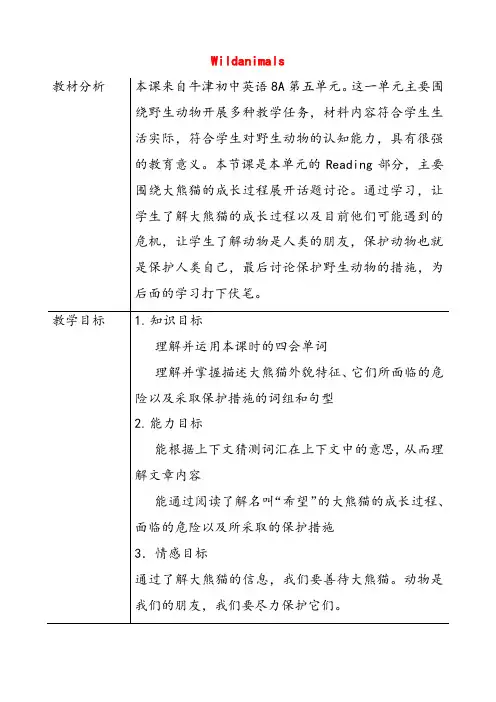
Wildanimals教学重难点理解文章大意,掌握语言授课类型新授讲授方法Task-basedteachingmethord教具准备PPT学生提前互动准备动物特征纸条、学生对人类要说的话奖励物品(小熊猫)教学过程及时间主要教学内容教学方法应用PartOnePre-reading 1.Aguessing game2.Presentne wwordsPartTwo While-readi Goodmorning,boysandgirls.Nicetomeetyou.Lastclasswehavelearntmanynamesofanimals.Doyourememberthem?Good.Let’splayaguessinggame,ok? Iwillaskonestudenttosaysthabouthisfa vouriteanimal.Theotherspleaseguesswhatitis.(Good.Let’sclapourhandsforthem) (Congratulationstoyou)Youareveryclever.Doyouwanttoknowmyfa vouriteanimal?Myfavouriteanimalisverylovely.Itisbl学生回答Yes请四位学生描述他最喜欢的动物的特征,其他人猜动物名称。
学生回答Yes请一位学ng1.Presentth ephotosofJa ckyChen2TaskOne Listenandfi ndthemainid ea:3TaskTwo Line1-14The growthofXiW ang4.TaskThree Line15-22Th eproblemsgi antpandasma ymeet5.TaskFour Line23-30Th ackandwhite.ItusuallylivesinChina.It sfavouritefoodisbambooshootsand leaves.Whatisit?(congratulations)(跟学生握手以示祝贺)(显示大熊猫图片)Look.Whatarethey?Look.Itisababypanda.(显示熊猫宝宝图片)Whatdogiantpandaslikeeating?(引出竹子图片)Lookatthepicture.Theyarebamboos.They arebambooleaves.Bambooshoots.Bambooforest.Lookatthispicture.Whoishe?Look.Heiswithapanda.Heistheambassado roflovingpandas.Doyouthinkheisgreat? DoyouwanttobesuchamanlikeJackyChen?I fyouwant,youmustknowthegiantpandasverywell.So,let’slearnastoryofagiantp andacalledXiWang.Openyourbooksontopage60.Firstlet’sl生回答Giantpanda学生回答theyaregiantpandas学生跟读新单词3遍学生回答Jac kyChen学生听录音完成第一个任务学生自行阅读完成表格,请几位学生eactionswec antakePartThreeAf ter-reading 1.Discussi on2.Watchavi deoPartFourHom ework istentothetapewithyourbook.Trytoputt hestoryintothreeparts.Youdidagoodjob. Ifyouwanttobeanambassadoroflovingpandas,youmustknowthegrowthofpandas. SopleasereadPart1byyourselvesandtryt ofinishthetable. NowIthinkyoucanfinishPartCinyourbookeasily.Aregiantpandaslovely? Buttheyhaveproblemsnow.Let’slearnPa rtTwoandseewhatproblemstheyhave. Closeyourbooksandlisten.Trytofillint heblanks.Yes.Thesearetheproblems.Doyouknowany otherproblemsforgiantpandas。
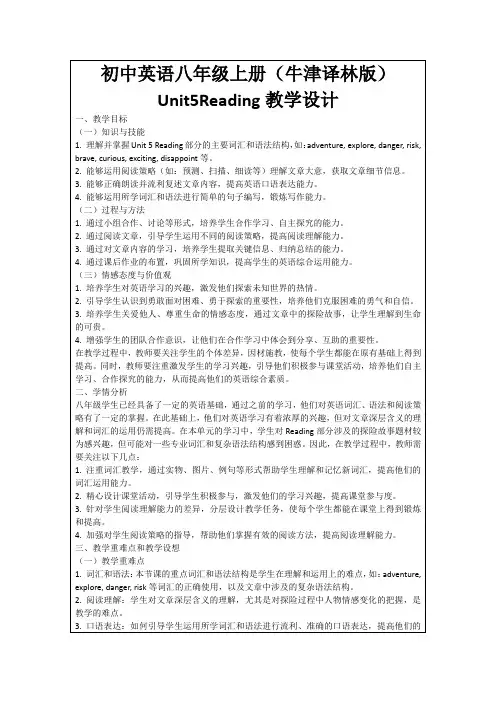
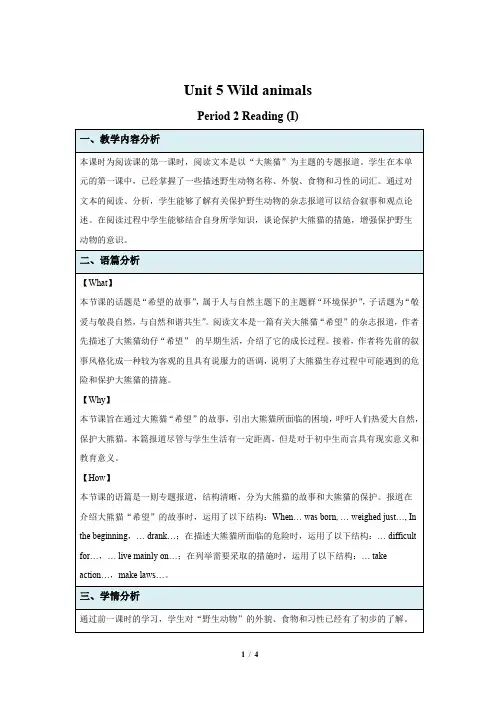
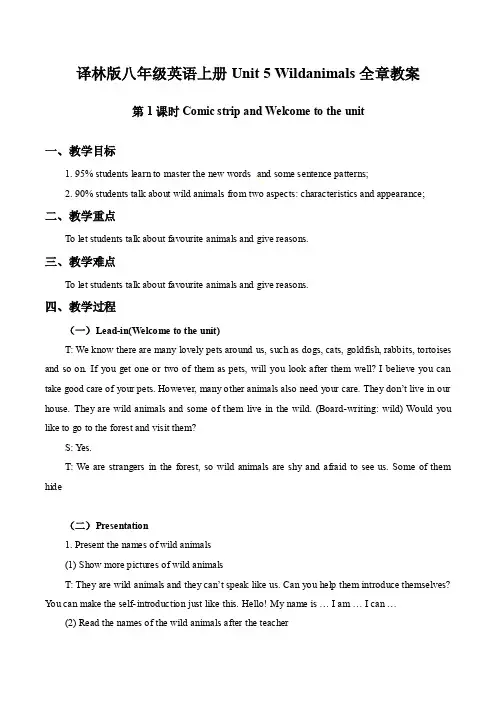
译林版八年级英语上册Unit 5 Wildanimals全章教案第1课时Comic strip and Welcome to the unit一、教学目标1. 95% students learn to master the new words and some sentence patterns;2. 90% students talk about wild animals from two aspects: characteristics and appearance;二、教学重点To let students talk about favourite animals and give reasons.三、教学难点To let students talk about favourite animals and give reasons.四、教学过程(一)Lead-in(W elcome to the unit)T: We know there are many lovely pets around us, such as dogs, cats, goldfish, rabbits, tortoises and so on. If you get one or two of them as pets, will you look after them well? I believe you can take good care of your pets. However, many other animals also need your care. They don’t live in our house. They are wild animals and some of them live in the wild. (Board-writing: wild) Would you like to go to the forest and visit them?S: Y es.T: We are strangers in the forest, so wild animals are shy and afraid to see us. Some of them hide(二)Presentation1. Present the names of wild animals(1) Show more pictures of wild animalsT: They are wild animals and they can’t speak like us. Can you help them introduce themselves? Y ou can make the self-introduction just like this. Hello! My name is … I am … I can …(2) Read the names of the wild animals after the teacherAsk the students to read these new words and phrases after the teacher for three times. Make sure all the students can read the names correctly. Then do Part A on page 57.(3) Finish Part A on page 57(4) Play a guessing gameT: Wild animals are our friends. It’s important to protect wild animals. Let’s check how much you know about wild animals. Let’s play a guessing game. Write the names on pieces of paper and then invite some students to choose and say something of the animals (To make it easier, ask the students to use the first person). The other students should listen carefully and guess what animal it is.Bear: I’m very big and strong. I like eating fish.Zebra: I look like a horse and can run fast. I have black-white stripes.Squirrel: I am small but lovely. I have a very big tail. I like eating nuts (坚果).Giant Panda: I am cute and I live in China. I hope that one day I can take a colour photo.Dolphin: I’m friendly and clever. I like playing balls and dancing in the sea. Who am I?Tiger: I’m the King of our forest. I’m dangerous. Don’t attack (攻击) me!2. Present the dialogue(1) Read the dialogue and answer the question.T: Millie and her classmates are talking about their favourite wild animals. Let’s listen to t heir conversation and then try to answer the question: What’s Simon’s favourite wild animal? (Play the recording of part B)S: He likes lions best.(2) Get the students to read the dialogue carefully and complete the table.(3) Get the students to read the dialogue together or in roles.(4)Get the students to make up dialogues.T: We have learned many kindsof wild animals. Can you tellme which wild animal you likebest and which one you likeleast? Then get the students totalk about their favourite wildanimals.(三)PracticeUse the following model tomake dialogue.A: Which animal do you like best?B: I like … best.A: Why?B: Because they are …A: Which animal do you like least?B: I like … least.A: Why?B: Because they are …(四)Lead-in(Comic strip)1. Look at the picture and answer the questionsT: Look at the picture. We all know him. He is our old friend Eddie. Is Eddie a wild animal?S: No. Because he doesn’t need to look for food in the wild.T: Well, Hobo and Eddie are talking about wild animals. Now let’s watch a short flash about their dialogue and try to answer the questions:(1) Will Eddie eat the wild animals? Why or why not?(2) Will Eddie eat the wild animal? Why or why not?2. Play the flash for them and then get some students to answer the question(五)Practice1. Play the tape again and get the students to read after it. Then ask them to fill in the blanks.T: Please listen to the tape again and repeat in groups, paying attention to the pronunciation and intonation.2.Work in pairs and read the dialogue in roles.(六)ConsolidationDivide the students into two groups: boy group and girl group. Boy group’s opinion: People can eat wild animals. Girl group’s opinion: People shouldn’t eat wild ani mals. They are given several minutes to prepare for the debate.(七)SummaryT: Wild animals are our friends. We shouldn’t eat or kill them. We should love and protect them. We should share the world with them!(八)Homework1. Finish some exercises of this period;2. Find more information about giant pandas;3. Preview Reading五、教学反思第2课时Reading(1)一、教学目标1. 95% students learn to get specific information by using the indicating words;2. 90% students to understand the understand the importance of protecting wild animals.二、教学重点To let students know the background of different wild animals in the world and talk about them 三、教学难点To let students know the background of different wild animals in the world and talk about them 四、教学过程(一)Lead-inEnjoy a video about Kungfu Panda II.T: Today, we’ll continue to learn about wild animals. First, let’s enjoy a video.T: As we can see, the panda in the film is very good at kungfu and it lives happily. But it is very difficult for real pandas to survive in the wild. They need our help, right? In fact, there are a lot of things that we can do to care about the pandas. We can join the WWF. We can design a leaflet to ask people to help the pandas. So, let’s think about how to design a leaflet. I am sure that you will know how to design it after learning this report on the baby panda Xi Wang.(二)Presentation1. Learn the new expressions(1) B rainstorm T: What do you know about giant pandas?(2) Present the new expressionsT: Most of you know that the giant pandas live mainly on bamboo. And you also know that the number of giant pandas is very small because they are facing serious problems. They are in danger. Shall we take action to protect them? (Show some pictures with the words: live mainly on, face serious problems, be in danger and take action right away.)T: In fact, there a re a lot of facts about giant pandas that you don’t know. In the arti cle, The Story of Xi Wang, you find them and think you will know how to protect them after reading it.2. Skim for the main idea of the whole text(1) Watch a video of the text and skim for the main idea of the articleT: First, let’s watch a video to get a general idea of the text.T: Can you find an easy way to get the main idea of the article quickly? (Group work)T: Sometimes, we can get the main idea of the whole article from the title, the pictures and the first and last paragraph.(2) Have a tryT: Let’s have a challenge to get the main idea of the text.3. Skim for the main idea of each paragraph(1) BrainstormT: The report is about the pandas, so let’s guess in what aspects we can introduce the pandas. We will use the mind map to help us. Here, I will give you a sample of the mind map.(2) Skim for the main ideas of paragraph 2 to 5T: All of you have thought of so many ideas. Now, let’s read paragraph 2-5 and find their main ideas to see whether you have made the right prediction.(3) Explain how to find out the main idea with the topic sentence.T: Here, I have a question for you. How did you find the main idea of paragraph 4? Can you circle the topic sentence?4. Understand the structure of the textT: So far, we have known how the report is organized. It is time for us to analyze the structure of the report. How many parts can the report be divided into? What are they? Please work in groups.5. Scanning for the specific information.(1) Finish the table.T: Boys and girls ,we have known the structure of this article and the main idea of each paragraph. Now, let’s get a close look at the article. First, let’s find out what the pandas eat and how much they weigh in different stages. Y ou can circle some useful words while looking for answers. Now, please listen to the tape and then finish the table.Information about Xiwang(2) DiscussionT: While looking for the answers, you may find some useful words that can help you quicklyfind the information you need. Can you circle them?(3) Scanning for the specific informationT: Next, let’s find out what problems the pandas face and what actions we can take. Y ou can circle some useful words while looking for answers.(4) Have a tryT: Let’s have a challenge to use the indicating words to find the answers.6.SummaryT: Now we have a better understanding of the text. Let’s review what we learnt.(三)Consolidation1. Retell the textT: Boys and girls, so far, we have learnt a lot of details about giant pandas. I think we can tell our friends or someone else about this lovely wild animal. Let’s retell the story. Here are some useful expressions for you.look like a white mouse weigh just 100 gramsat four months oldeightmonthslater not … any morein the beginninglook after herselfface serious problemsit is difficult for … to …live mainly on become smaller and smalleras a resultbe in danger take action2. Finish a leafletT: We need to take action to help them right now. Please design a leaflet to ask people to care about giant pandas. Here are some useful expressions.… be born in the beginning when … Sadly …for example …Also... in danger take action3.SummaryT: No buying, no killing!(五)Homework1. Search the internet to find out more ways to protect wild animals;2. Finish the paper.五、当堂检测The baby panda called Xi Wang weighed just 100 grams at______and looked______a white mouse.At four months old,she began to go outside for the ______time.Eight months later,she weighed______35kilograms.In the beginning, Xi Wang drank her mother’s milk.When she was six months old,she began to eat______.When she was 20 months old,she learnt to look after______.Sadly,giant pandas face serious problems in the________.For example,it is very difficult for pandas to have_______,and many baby pandas die when they are very young.Also,giant pandas live______on a special kind of bamboo.However,the bamboo_______are becoming smaller and smaller.As a result,pandas may not have a place to live or ______to eat.Giant pandas are now in _____.We should take action right away.We can help pandas have ______babies,build more panda reserves or make ______to protect pandas.There are now only about 1,600 pandas in the wild.If we do nothing,______there may be none left!Keys:1.birth 2.like 3.first 4.over 5.bamboo 6.herself 7.wild 8.babies9.mainly 10.forests 11.food 12.danger 13.more ws 15.soon六、教学反思第3课时Reading(2)一、教学目标1. 100% students can have a deeper understanding of the report;2. 90% student can use the new words and phrases properly;3. 85% students learn to rewrite the report in the perspective of Xi Wang.二、教学重点To let students have a deeper understanding of the report;三、教学难点To let students have a deeper understanding of the report;四、教学过程(一)Revision1. Have a revision of the basic information about giant pandasT: Hello, everyone! We have learnt a story about a baby panda called Xi Wang. In today’s lesson, we will have a revision of the story and learn something useful from the story. First, I want to know how much you know about Xi Wang. Please answer the following questions.(1) What did she look like when she was born?(2) What could she do when she was 4 months old?(3) What do pandas eat when they grow up?2. Have a revision of the problems that giant pandas face and the actions that we can take to protect them.(二)Practice1. ExercisesT: Now, let’s have a challenge to see whether you can use the new language points in exams.(1) Fill in the blanks with the correct forms of the words in the brackets.a. Although she _________ (bear) in America, she spent her childhood in China. (was bo rn)b. When the sun appeared in the east, the sky starts ________ (get) brighter and brighter. (toget)c. People in North China _________ (main) on wheat. (mainly)d. Sanjiangyuan is one of the biggest nature ________ (自然保护区) in the world. (reserves)e. We should not do something against the _________ (法律) in the protected areas. (laws)(2) Translate the following sentences into Englisha. 现在大多数野生动物都面临严重的问题。
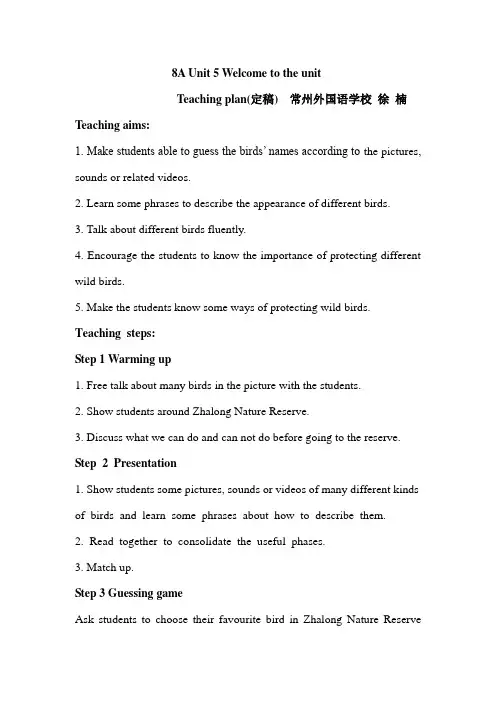
8A Unit 5 Welcome to the unitTeaching plan(定稿) 常州外国语学校徐楠Teaching aims:1. Make students able to guess the birds’ names according to the pictures, sounds or related videos.2. Learn some phrases to describe the appearance of different birds.3. Talk about different birds fluently.4. Encourage the students to know the importance of protecting different wild birds.5. Make the students know some ways of protecting wild birds. Teaching steps:Step 1 Warming up1. Free talk about many birds in the picture with the students.2. Show students around Zhalong Nature Reserve.3. Discuss what we can do and can not do before going to the reserve. Step 2 Presentation1. Show students some pictures, sounds or videos of many different kinds of birds and learn some phrases about how to describe them.2. Read together to consolidate the useful phases.3. Match up.Step 3 Guessing gameAsk students to choose their favourite bird in Zhalong Nature Reserveand try to describe it on the paper (at least 5 sentences), and then let others guess what bird it is.Step 4 Pair-workSuppose your old friend Hobo is calling you now. He is asking you something about your visit to Zhalong Nature Reserve. Try to make a dialogue with him about what you see here.Step 5 Comic strips—Listen and answer1. Does Eddie really like birdwatching?2. Where does Eddie think is the best place to watch birds?3. Why does Eddie think so?Step 6 DiscussionCan we eat different kinds of wild birds at the restaurant in Zhalong Nature Reserve? If not, what can we eat there?Is it right or wrong for people to eat different kinds of wild birds? Why? Step 7 Pair-workA red-crowned crane and a golden eagle are talking about their unlucky experiences outside the reserve before and the pleasant life in the reserve now. Try to make a dialogue to encourage people not to hunt wild birds. ( food, living areas, danger, people’s actions…)Step 8 Group discussion How can we protect wild birds?Step 9 HomeworkWrite a short dairy about your visit to Zhalong Nature Reserve.学╝优%中∽考╗,网。
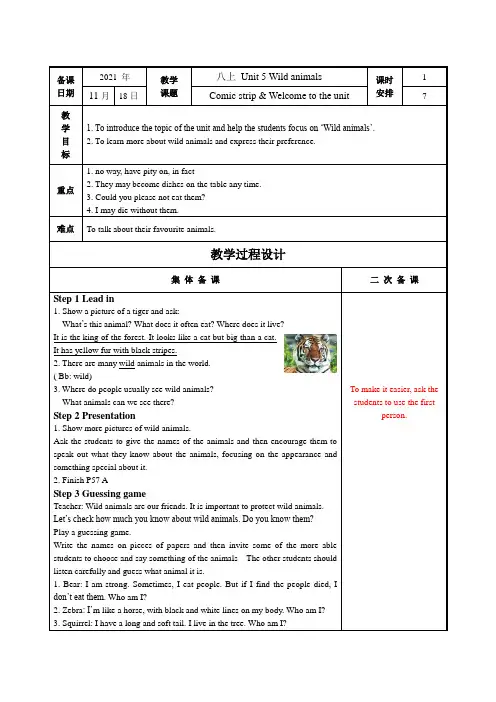
备课日期2021 年教学课题八上Unit 5 Wild animals课时安排1 11月18日Comic strip & Welcome to the unit7教学目标1. To introduce the topic of the unit and help the students focus on ‘Wild animals’.2. To learn more about wild animals and express their preference.重点1. no way, have pity on, in fact2. They may become dishes on the table any time.3. Could you please not eat them?4. I may die without them.难点To talk about their favourite animals.教学过程设计集体备课二次备课Step 1 Lead in1. Show a picture of a tiger and ask:What’s this animal? What does it often eat? Where does it live?It is the king of the forest. It looks like a cat but big than a cat.It has yellow fur with black stripes.2. There are many wild animals in the world.( Bb: wild)3. Where do people usually see wild animals?What animals can we see there?Step 2 Presentation1. Show more pictures of wild animals.Ask the students to give the names of the animals and then encourage them to speak out what they know about the animals, focusing on the appearance and something special about it.2. Finish P57 AStep 3 Guessing gameTeacher: Wild animals are our friends. It is important to protect wild animals. Let’s check how much you know about wild animals. Do you know them?Play a guessing game.Write the names on pieces of papers and then invite some of the more able students to choose and say something of the animals The other students should listen carefully and guess what animal it is.1. Bear: I am strong. Sometimes, I eat people. But if I find the people died, I don’t eat them. Who am I?2. Zebra: I’m like a horse, with black and white lines on my body. Who am I?3. Squirrel: I have a long and soft tail. I live in the tree. Who am I? To make it easier, ask the students to use the firstperson.4. Giant Panda: I have black eyes and four black paws. I like eating bamboo shoots. I am very lovely. Who am I?5. Dolphin: I like swimming. I can do different kinds of swimming shows. Many people bring their children to watch my shows. Who am I?6. Tiger: I am the king of the animals. I look like a cat but I’m bigger than a ca t. Usually, I have yellow fur and black stripes. Who am I?Step 4 PracticeP57 B1. T: Millie and her classmates are talking about their favourite wild animals. Let’s listen to their conversation and find their favourite wild animals.Simon Kitty Peter & Millie2. Play the tape again and let Ss read.3. Get the students to read the dialogue together or in roles.4. Ask the students to talk about their favourite (or they like best/least) wild animals. If possible, encourage them to mention some simple reasons.Step 5 Getting to know about wild animalsMan is now having the same problem too. Many animals share the same homeland with us. However, man has taken their food and their homes away. Ask, ‘Do you think we should do something to help?’ (Yes.)Wild animals are our friends. It is important to protect wild animals.(Write the sentence on the board then get the students to read it aloud.)‘Let’s check how much you know about wild animals. Do you know them?’ Show the pictures of the animals.Ask the students to give the names of the animals and then encourage them to speak out what they know about the animals, focusing on the appearance and something special about it.Step 6 Comic stripT: Is Hobo a wild animal?1. Present the pictures of the comic and let Ss guess what they say.2. Listen to their conversation and answer the following questions.Would Eddie like to live in the wild? Why or why not?3. Get the students to focus on possible actions and possible results of the dialogue. Then get them to finish the following exercises. Ask the students to talk about their favourite (or they like best/least) wildanimals课后作业Find more information about wild animals and finish the exercises. Recite the two dialogues.教学反思唤起学生以往学过的动物名称的回忆,复习一下,适当可以扩大一下范围。
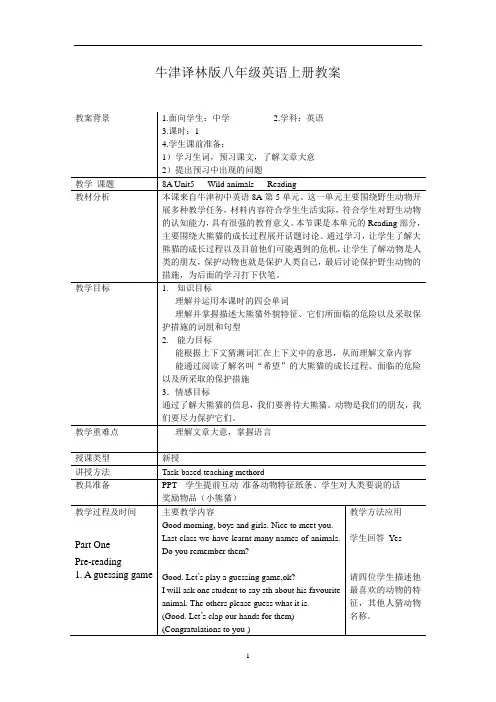
牛津译林版八年级英语上册教案教案背景 1.面向学生:中学 2.学科:英语3.课时:14.学生课前准备:1)学习生词,预习课文,了解文章大意2)提出预习中出现的问题教学课题8A Unit5 Wild animals Reading教材分析本课来自牛津初中英语8A第5单元。
这一单元主要围绕野生动物开展多种教学任务,材料内容符合学生生活实际,符合学生对野生动物的认知能力,具有很强的教育意义。
本节课是本单元的Reading部分,主要围绕大熊猫的成长过程展开话题讨论。
通过学习,让学生了解大熊猫的成长过程以及目前他们可能遇到的危机,让学生了解动物是人类的朋友,保护动物也就是保护人类自己,最后讨论保护野生动物的措施,为后面的学习打下伏笔。
教学目标 1.知识目标理解并运用本课时的四会单词理解并掌握描述大熊猫外貌特征、它们所面临的危险以及采取保护措施的词组和句型2.能力目标能根据上下文猜测词汇在上下文中的意思,从而理解文章内容能通过阅读了解名叫“希望”的大熊猫的成长过程、面临的危险以及所采取的保护措施3.情感目标通过了解大熊猫的信息,我们要善待大熊猫。
动物是我们的朋友,我们要尽力保护它们。
教学重难点理解文章大意,掌握语言授课类型新授讲授方法Task-based teaching methord教具准备PPT 学生提前互动准备动物特征纸条、学生对人类要说的话奖励物品(小熊猫)教学过程及时间主要教学内容教学方法应用Part OnePre-reading1. A guessing game Good morning, boys and girls. Nice to meet you.Last class we have learnt many names of animals.Do you remember them?Good. Let’s play a guessing game,ok?I will ask one student to say sth about his favouriteanimal. The others please guess what it is.(Good. Let’s clap our hands for them)(Congratulations to you )学生回答Yes请四位学生描述他最喜欢的动物的特征,其他人猜动物名称。
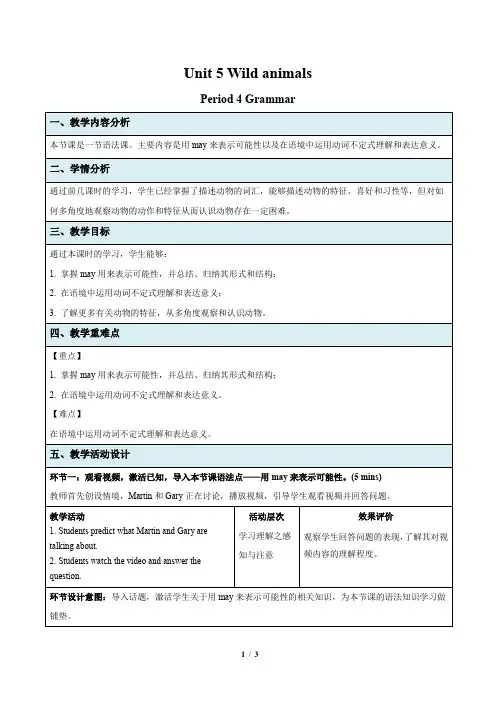
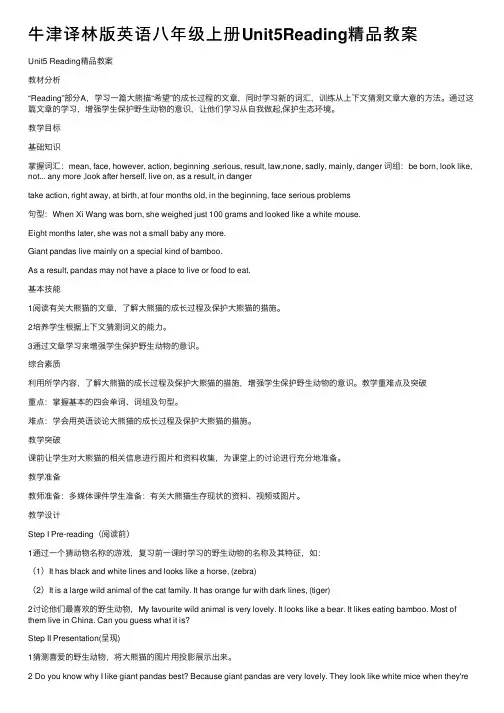
⽜津译林版英语⼋年级上册Unit5Reading精品教案Unit5 Reading精品教案教材分析“Reading”部分A,学习⼀篇⼤熊描“希望”的成长过程的⽂章,同时学习新的词汇,训练从上下⽂猜测⽂章⼤意的⽅法。
通过这篇⽂章的学习,增强学⽣保护野⽣动物的意识,让他们学习从⾃我做起,保护⽣态环境。
教学⽬标基础知识掌握词汇:mean, face, however, action, beginning ,serious, result, law,none, sadly, mainly, danger 词组:be born, look like, not... any more ,look after herself, live on, as a result, in dangertake action, right away, at birth, at four months old, in the beginning, face serious problems句型:When Xi Wang was born, she weighed just 100 grams and looked like a white mouse.Eight months later, she was not a small baby any more.Giant pandas live mainly on a special kind of bamboo.As a result, pandas may not have a place to live or food to eat.基本技能1阅读有关⼤熊猫的⽂章,了解⼤熊猫的成长过程及保护⼤熊猫的措施。
2培养学⽣根据上下⽂猜测词义的能⼒。
3通过⽂章学习来增强学⽣保护野⽣动物的意识。
综合素质利⽤所学内容,了解⼤熊猫的成长过程及保护⼤熊猫的措施,增强学⽣保护野⽣动物的意识。
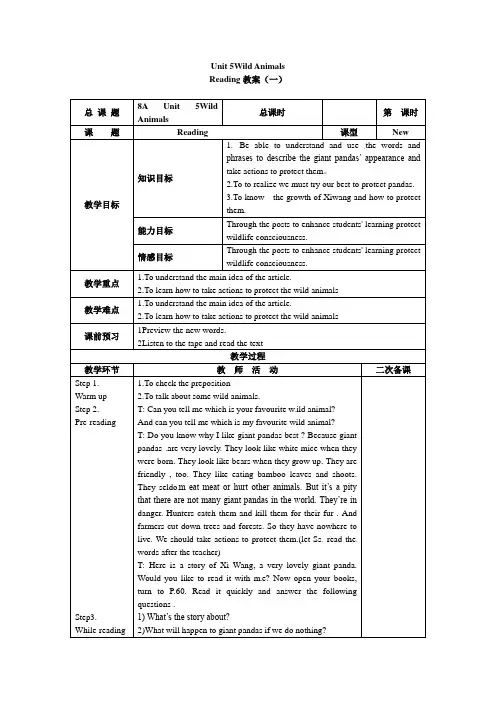
Unit 5Wild Animals Reading教案(一)总课题8A Unit 5WildAnimals总课时第课时课题Reading 课型New教学目标知识目标1.Be able to understand and use the words andphrases to describe the giant pandas’ appearance andtake actions to protect them。
2.To to realize we must try our best to protect pandas.3.To know the growth of Xiwang and how to protectthem.能力目标Through the posts to enhance students' learning protectwildlife consciousness.情感目标Through the posts to enhance students' learning protectwildlife consciousness.教学重点1.To understand the main idea of the article.2.To learn how to take actions to protect the wild animals教学难点1.To understand the main idea of the article.2.To learn how to take actions to protect the wild animals课前预习1Preview the new words.2Listen to the tape and read the text教学过程教学环节教师活动二次备课Step 1. Warm up Step 2.Pre-readingStep3.While-reading 1.To check the preposition2.To talk about some wild animals.T: Can you tell me which is your favourite w ild animal?And can you tell me which is my favourite wild animal?T: Do you know why I like giant pandas best ? Because giant pandas are very lovely. They look like white mice when they were born. They look like bears when they grow up. They are friendly , too. They like eating bamboo leaves and shoots. They seldo m eat meat or hurt other animals. But it’s a pity that there are not many giant pandas in the world. They’re in danger. Hunters catch them and kill them for their fur . And farmers cut down trees and forests. So they have nowhere to live. We should take actions to protect them.(let Ss read the words after the teacher)T: Here is a story of Xi Wang, a very lovely giant panda. Would you like to read it with m e? Now open your books, turn to P.60. Read it quickly and answer the following questions .1) What’s the story about?2)What will happen to giant pandas if we do nothing?Step4Post-readingStep5 SummaryStep6. Homework T: Now , listen to the tape and read after it and then answer the six questions on the screen . Then encourage the students to find the main ideas about this story.T: Now Let’s find the main ideas together and put them on the blackboard.T: Look at the screen . Finish the table of “The growth o f Xi Wang”. Catch more details about XiWang.T: Now please read the passage together . Then finish the exercises on P. 61 Part B And Part C.T: Now , We’ve known the giant pandas very well , They are very lovely and we love them very much . But th ere are fewer and fewer pandas in the world . They’re in danger . Do you know why? Now,work in groups and find out “What problems can a giant panda meet in its life?”Then ask some able students of each group to talk in front of the class. After that,finish the Note-making 2 on the screen. T: Discuss with your partners: What other problems will the giant pandas have? What actions can we take ?And can you have a face to face interview about pandas?Teacher makes a summary that we should take actions to protect gian t pandas.1.Write an article about “what’s the relationship between wild animals and human beings?”2.Finish the exercises of reading教学反思总课题8A Unit 5Wild Animals 总课时第课时课题Reading 课型New教学目标知识目标1.Learing and using the language points2.To develop the Ss’ abilities of using English3.To train the Ss’ ability of learning by doing.能力目标To train the Ss’ ability of learning by doing.情感目标To learn how to take actions to protect the wild animals 教学重点Retell the reading and use the language points correctly.教学难点Retell the reading and use the language points correctly.课前预习Listen to the tape and read the text Revise the ways to give directions教学过程教学环节教师活动二次备课Step1 RevisionStep2 Language points 1 Say something about giant pand as2 Finish the table about the growth of Xiwang3 Review what danger giant pandas meet and what actions we can take4. Fill in blanks with proper forms.Explain the following language points to students1.be in danger.Many wild animals are in danger.2. She grew into a healthy young giant panda and weighed 35 kilograms. grow into意为“长成----”“发展成----”,其中grow作行为动词;weigh v.称重weighed weight n.重3.encourage sb to do sth.The English teacher always encourages me to speak more in class.4. following adj.We must take the following actions to learn English well.5. have nowhere to liveIf farmers cut down trees and forests, giant pandas will have nowhere to live.6.At the very beginning, XiWang drankhermother’s milk for up to 14 hours a day.at th e very beginning 在开始时At the very beginning, I didn’t like maths.Up to意为“高达,达到,一直到”。
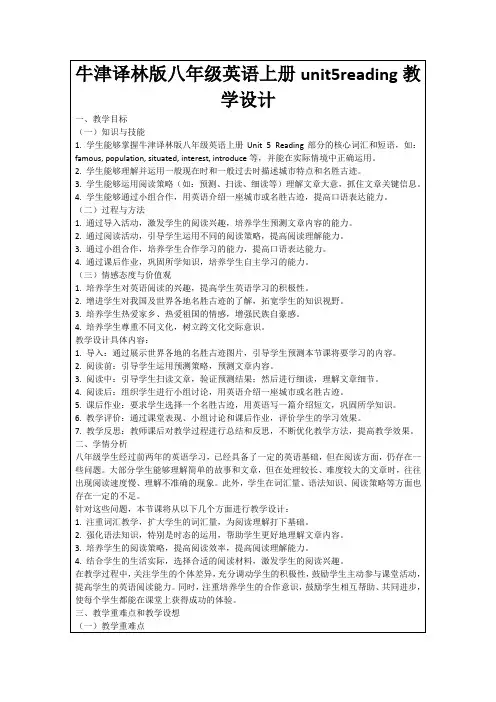
初中英语牛津译林版八年级上册Unit5《Integrated skills》优质课教案省级比赛获奖教案公开课教师面试试讲教案【名师授课教案】1教学目标1.帮助学生从听力材料中获取有关老虎和狼的外貌特征、性格特点、能力、主要食物以及各自所面临的危险等方面的情况,学习并运用描写野生动物外貌、性格、能力、食物以及面临危险的词汇和句型。
2.从听力材料中准确获取相关有用的信息,谈论老虎和狼,以达到提高语言运用能力的目标。
3.通过了解野生动物面临的危险,激发学生保护、爱护野生动物的情感和意识,培养学生的人道主义精神,教育学生对和谐社会的追求,努力践行和谐的社会主义价值观。
2学情分析本次上课的八年级学生从小学一年级开始学习英语,他们已经具备了一定的英语阅读能力,听、说、写的能力在原有的基础上也得到了进一步的提高。
但是,随着他们年龄的增长以及其它客观因素的影响,学生参与课堂的积极性有所下降。
针对以上学情,笔者在教学设计时重在激发学生的学习英语兴趣,让他们愿意主动去涉取知识。
Integrated skills这一部分是延续本单元的话题保护野生动物,这是学生熟悉而感兴趣的内容,在前几个课时中学生已经学过一些珍稀动物的名称,不过学生对于野生动物所面临的危险,还缺乏保护的意识,或者是认识不全面、不深刻。
因此,本课时学生的主要任务是学习并运用描写野生动物外貌、性格、能力、食物以及面临危险的词汇和句型,通过学习课文了解野生动物面临的危险,养成保护、爱护野生动物的意识。
同时,培养学生的英语阅读能力以及综合运用语言的能力。
3重点难点Learn to use the words and sentence pattern properly to talk about characteristics, app earance, abilities, eating habits and danger in the context of wild animals, practice E nglish in situational conversation.4教学过程4.1第一学时教学活动1【导入】图片激趣Step 1 warm up and lead in (2 minutes)Lead in the two new animals (tiger and wolf) through revising the animals we have learn t in reading and vocabulary.1.Show some pictures of wild animals(squirrel 、bear、kangaroo、elephant、giant panda、d olphin、giraffe、wolf and tiger).T: In this unit, we have learned a lot about wild animals. Please guess what kind of an imal it is according to description in the video.。
课堂教学设计课题Unit 5 Wild animals Comic strip and welcome to the unit集体备课和个人修改意见教时1 课型新授主备人备课时间2021,12,20教学三维目标语言知识1.Talking about the animals2.To enable the Ss to love animals and love life.3.To train the Ss’ ability of working in pairs.语言技能1.To describe different animals according to personal preferences.2.How to say something about wild animals in English.3.How to arouse the feeling of loving the animals.情感态度To enable the Ss to love animals and love life.教学四点纲要教学重点1.How to say something about wild animals in English.2.How to arouse the feeling of loving the animals.教学难点Learn the proper and easy ways to write something, Identify keywords.课标点1.How to say something about wild animals in English.2.How to arouse the feeling of loving the animals.中考点1.How to say something about wild animals in English.2.How to arouse the feeling of loving the animals.教学五点设想1.教师呈现一副学生比较熟悉的野生动物的图片,问学生问题,并告诉学生,引入话题;2.教师巡视,并对学生开展问答时出现的问题给予正确指导,并一一板书;3.先让学生听对话,再次播放录音,让学生跟读;4.就学生喜欢的野生动物做一个简单的汇报,并说明理由;5.指导学生带着问题听录音并理解相关内容。
Unit5 Integrated skills名师教案I. Teaching aims and learning objectivesBy the end of the lesson, students should be able to:1. grasp the sentences about specific characteristic, appearance, abilities, eating habits and danger in the context of animals;2. obtain the key information from listening;3. express opinions about protecting wild animals;4. be more aware of the importance of protecting the wild animals by listening and speaking.II. Teaching contents1. New words and phrases: while, catch, thick, lose, living, kill, human, sorry, pity,sell, shame, act, stripe, quality, hunter, wolf, for a shortwhile, live alone, smell things far away, work as a team,kill for fun, lose living area, yours sincerely2. New structure: I’m sorry to hear that.It’s a great pity!What a shame!We shouldn’t buy fur coats any more.I think everybody should act to protect wild animals.III. Focus of the lesson and predicted area of difficultyObtain the key information from listening.Express opinions about protecting wild animals.ⅣPreview(课前预习)活动一:爱搜集:What’s your favourite wild animal??搜集与野生动物相关的资料,拍照片、截图上传,或上传视频,与同学分享。